Islam
| I | INTRODUCTION |
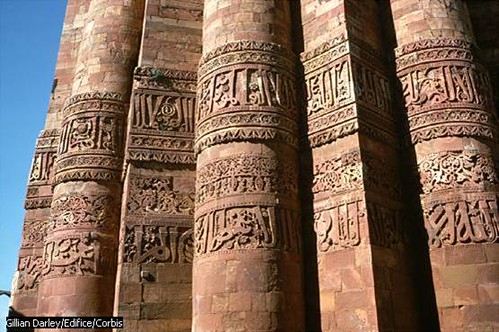
The Qur’an
The inscription on buildings of verses from the Qur’an symbolizes the living presence of the holy book in Islamic society. This tower with decorative Qur’anic inscriptions is in Delhi, India.
Gillian Darley/Edifice/Corbis
Islam, one of the three major world religions, along with Judaism and Christianity, that profess monotheism, or the belief in a single God.
In the Arabic language, the word Islam means “surrender” or “submission”—submission to the will of God. A follower of Islam is called a Muslim, which in Arabic means “one who surrenders to God.” The Arabic name for God, Allah, refers to the God worshiped by Jews and Christians. Islam’s central teaching is that there is only one all-powerful, all-knowing God, and this God created the universe. This rigorous monotheism, as well as the Islamic teaching that all Muslims are equal before God, provides the basis for a collective sense of loyalty to God that transcends class, race, nationality, and even differences in religious practice. Thus, all Muslims belong to one community, the umma, irrespective of their ethnic or national background.
Within two centuries after its rise in the 7th century, Islam spread from its original home in Arabia into Syria, Egypt, North Africa, and Spain to the west, and into Persia, India, and, by the end of the 10th century, beyond to the east. In the following centuries, Islam also spread into Anatolia and the Balkans to the north, and sub-Saharan Africa to the south. The Muslim community comprises about 1 billion followers on all five continents, and Islam is the fastest-growing religion in the world. The most populous Muslim country is Indonesia, followed by Pakistan and Bangladesh. Beyond the Middle East, large numbers of Muslims live in India, Nigeria, the former republics of the Union of Soviet Socialist Republics (USSR), and China.
One of the reasons for the growth of the Muslim community has been its openness to new members. Children born to Muslim parents are automatically considered Muslim. At any time, a non-Muslim can convert to Islam by declaring himself or herself to be a Muslim. A person’s declaration of faith is sufficient evidence of conversion to Islam and need not be confirmed by others or by religious authorities.
| II | THE TEACHINGS OF MUHAMMAD |
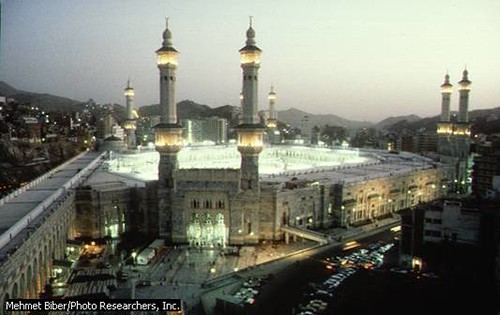
Mecca, Saudi Arabia
The al-Haram Mosque in Mecca, Saudi Arabia, holds the holiest shrine of Islam, the Kaaba. As the birthplace of Islam’s founder, the Prophet Muhammad, Mecca is considered a holy city. It is a pilgrimage point for Muslims worldwide, who are expected to visit the city at least once if they are able to do so.
Mehmet Biber/Photo Researchers, Inc.
Around the year ad 570 Muhammad, the founding prophet of Islam, was born in Mecca, at the time the central city of the Arabian Peninsula. Some 40 years later Muhammad started preaching a new religion, Islam, which constituted a marked break from existing moral and social codes in Arabia. The new religion of Islam taught that there was one God, and that Muhammad was the last in a series of prophets and messengers. Through his messengers God had sent various codes, or systems of laws for living, culminating in the Qur’an (Koran), the holy book of Islam. These messengers were mortal men, and they included among many others Moses, the Hebrew prophet and lawgiver, and Jesus, whom Christians believe to be the son of God rather than a prophet.
Islam also taught that the Christian Bible (which includes the Hebrew Bible as the Old Testament and an additional 27 books referred to as the New Testament), and the Qur'an were all holy books. According to the Qur’an, the two earlier Scriptures had been altered over time from their original forms given by God, while the Qur'an would remain perfect, preserved by God from such distortion. In addition to distinguishing itself from the Hebrew and Christian traditions, the new religion taught that the God of Islam had provided humanity with the means to know good from evil, through the prophets and the Qur’an. Therefore, on the Day of Judgment people will be held accountable for their actions.
Muhammad’s teachings met with severe and hostile opposition, and in the year 622 he left Mecca and sought refuge in the city of Yathrib, as a number of his followers had already done. Upon Muhammad's arrival, the name Yathrib was changed to Medina (meaning “the city”). The date of Muhammad's immigration was later set as the beginning of the 12-month lunar Islamic calendar.
| III | THE FIVE PILLARS |
During the ten years between his arrival in Medina and his death in ad 632, Muhammad laid the foundation for the ideal Islamic state. A core of committed Muslims was established, and a community life was ordered according to the requirements of the new religion. In addition to general moral injunctions, the requirements of the religion came to include a number of institutions that continue to characterize Islamic religious practice today. Foremost among these were the five pillars of Islam, the essential religious duties required of every adult Muslim who is mentally able. The five pillars are each described in some part of the Qur’an and were already practiced during Muhammad's lifetime. They are the profession of faith (shahada), prayer (salat), almsgiving (zakat), fasting (sawm), and pilgrimage (hajj). Although some of these practices had precedents in Jewish, Christian, and other Middle Eastern religious traditions, taken together they distinguish Islamic religious practices from those of other religions. The five pillars are thus the most central rituals of Islam and constitute the core practices of the Islamic faith.
Many polemical descriptions of Islam have focused critically on the Islamic concept of jihad. Jihad, considered the sixth pillar of Islam by some Muslims, has been understood to mean holy war in these descriptions. However, the word in Arabic means 'to struggle' or 'to exhaust one's effort,' in order to please God. Within the faith of Islam, this effort can be individual or collective, and it can apply to leading a virtuous life; helping other Muslims through charity, education, or other means; preaching Islam; and fighting to defend Muslims. Western media of the 20th century continue to focus on the militant interpretations of the concept of jihad, whereas most Muslims do not.
| A | The Profession of Faith |
The absolute focus of Islamic piety is Allah, the supreme, all knowing, all-powerful, and above all, all-merciful God. The Arabic word Allah means “the God,” and this God is understood to be the God who brought the world into being and sustains it to its end. By obeying God's commands, human beings express their recognition of and gratitude for the wisdom of creation, and live in harmony with the universe.
The profession of faith, or witness to faith (shahada), is therefore the prerequisite for membership in the Muslim community. On several occasions during a typical day, and in the saying of daily prayers, a Muslim repeats the profession, 'I bear witness that there is no god but Allah and that Muhammad is his messenger.' There are no formal restrictions on the times and places these words can be repeated. To become a member of the Muslim community, a person has to profess and act upon this belief in the oneness of God and the prophethood of Muhammad. To be a true profession of faith that represents a relationship between the speaker and God, the verbal utterance must express genuine knowledge of its meaning as well as sincere belief. A person’s deeds can be subjected to scrutiny by other Muslims, but a person’s utterance of the profession of faith is sufficient evidence of membership in the Muslim community and cannot be challenged by other members of this community.
| B | The Five Daily Prayers |
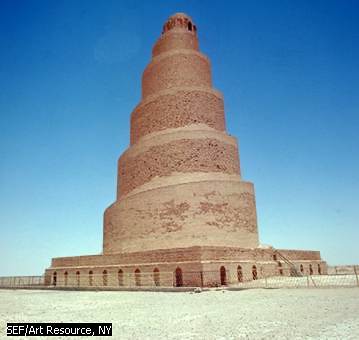
Minaret of the Great Mosque at Sāmarrā’
This spiral minaret, where the muezzin once called the faithful to prayer, is the only surviving feature of the Great Mosque at Sāmarrā’, Iraq. At the time of its construction (848-852), the Great Mosque at Sāmarrā’ was the largest Islamic mosque in the world.
SEF/Art Resource, NY
The second pillar of Islam is the religious duty to perform five prescribed daily prayers or salat. All adult Muslims are supposed to perform five prayers, preceded by ritual cleansing or purification of the body at different intervals of the day. The Qur’anic references also mention the acts of standing, bowing, and prostrating during prayers and facing a set direction, known as qibla. The Muslims were first required to face Jerusalem during prayer, but already during Muhammad's lifetime they were commanded to face the Kaaba, an ancient shrine in the city of Mecca. The Qur’an also refers to the recitation of parts of the Qur’an as a form of prayer. However, even with its numerous references, the Qur’an alone does not give exact instructions for this central ritual of prayer.

Layout of a Mosque
Mosques are laid out in accordance with Muslim prayer. They are generally organized around a courtyard, a reminder of the courtyard of Muhammad’s house, which served as the first mosque. Muslims pray facing the holy city of Mecca, a direction known as the qibla. A mihrab, or prayer niche, indicates the qibla, and the main prayer hall stands on the qibla side. Worshipers, called to prayer by a crier from the minaret, may hear a sermon delivered from the mimbar near the mihrab. A mosque that has a vaulted hall, or eyvan on each side of its courtyard, as this mosque does, is known as a four-eyvan mosque.
© Microsoft Corporation. All Rights Reserved.
A prayer is made up of a sequence of units called bowings (rak’as). During each of these units, the worshiper stands, bows, kneels, and prostrates while reciting verses from the Qur’an as well as other prayer formulas. With some variations among different Muslim sects, at noon, afternoon, and evening prayers, these units are repeated four times, while during the sunset prayer they are repeated three times, and at dawn only twice. The opening chapter of the Qur’an, al-Fatiha, is repeated in each unit in a prayer sequence. Each prayer concludes with the recitation of the profession of faith followed by the greeting 'may the peace, mercy, and blessings of God be upon you.'
Wherever Muslims live in substantial numbers throughout the world, the call to prayer, or adhan, is repeated five times a day by a muezzin (crier) from a mosque, the Muslim place of worship. Muslims are encouraged to pray together in mosques, but group prayer is only a religious obligation for the noon prayer on Friday. Women, travelers, sick Muslims, and those attending to the sick are granted license not to attend the Friday congregational prayer, although they may attend if they wish.
The Friday noon prayer is led by an imam, who is simply a prayer leader; this prayer differs from the usual noon prayers of the other days of the week. As a required part of the ritual at this congregational meeting, two sermons precede the prayer. On other days, Muslims can pray anywhere they wish, either individually or in groups. They must observe the rituals of praying at certain times of day, facing in the direction of Mecca, observing the proper order of prayers, and preparing through symbolic purification. Depending on the situation, this last ritual of ablution requires either total washing of the body or a less elaborate ritual washing of the hands, mouth, face, and feet.
In addition to the five required daily prayers, Muslims can perform non-obligatory prayers, some of which have fixed ritual formats and are performed before or after each of the five daily prayers. Others are performed at night, either individually or with other Muslims. These additional formal and informal prayers give expression to the primary function of prayer in Islam, which is personal communication with God for the purpose of maintaining the abiding presence of the divine in the personal lives of Muslims. The more formal aspects of prayer also serve to provide a disciplined rhythm that structures the day and fosters a sense of community and shared identity among Muslims.
| C | Almsgiving |
The third pillar of Islam is zakat, or almsgiving. A religious obligation, zakat is considered an expression of devotion to God. It represents the attempt to provide for the poorer sectors of society, and it offers a means for a Muslim to purify his or her wealth and attain salvation. The Qur’an, together with other Islamic traditions, strongly encourages charity and constantly reminds Muslims of their moral obligation to the poor, orphans, and widows; however, it distinguishes between general, voluntary charity (sadaqa) and zakat, the latter being an obligatory charge on the money or produce of Muslims. While the meaning of terms has been open to different interpretations, the Qur’an regularly refers to zakat, identifying specific ways in which this tax can be spent. These specific uses include spending zakat on the poor and the needy, on those who collect and distribute zakat, on those whom Muslims hope to win over and convert to Islam, on travelers, on the ransom of captives, to relieve those who are burdened with debts, and on the cause of God.
The Qur’an provides less-detailed information about the kinds of things that are subject to the zakat tax or the precise share of income or property that should be paid as zakat. These determinations are provided in the traditions of the prophet Muhammad and have been the subject of elaborate discussions among Muslim legal experts, or jurists. For example, one-fortieth (2.5 percent) of the assets accumulated during the year (including gold, silver, and money) is payable at the end of the year, while one-tenth of the harvest of the land or date trees is payable at harvest time. Cattle, camels, and other domestic animals are subject to a more complex taxation system that depends on the animals in question, their age, the numbers involved, and whether they are freely grazing. Traditional zakat laws do not cover trade, but commercial taxes have been imposed by various Muslim governments throughout history.
| D | Fasting |
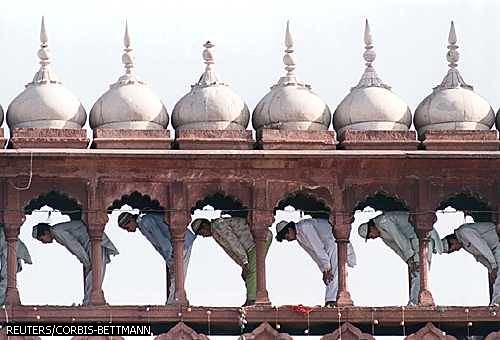
Last Day of Ramadan
Muslims pray in the upper gallery of a main mosque in the old walled city of Delhi, India. They are celebrating the end of Ramadan, the holy month of fasting as ordained by the Qur’an, the sacred scriptures of Islam.
REUTERS/CORBIS-BETTMANN
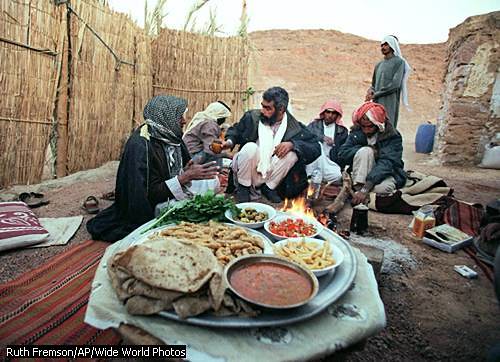
Festivities Ending Ramadan
Members of the Tarabin Bedouin tribe in Egypt prepare food for a three-day festival that marks the end of the Islamic holy month, Ramadan. During Ramadan adult Muslims fast from sunrise to sunset.
Ruth Fremson/AP/Wide World Photos
According to various traditional interpretations, the fast introduces physical and spiritual discipline, serves to remind the rich of the misfortunes of the poor, and fosters, through this rigorous act of worship, a sense of solidarity and mutual care among Muslims of all social backgrounds. Thus Muslims usually engage in further acts of worship beyond the ordinary during Ramadan, such as voluntary night prayer, reading sections from the Qur’an, and paying voluntary charity to the poor. Muslims may even choose to wake before daybreak to eat a meal that will sustain them until sunset. After the fasting ends, the holiday of breaking the fast, ‘id al-fitr, begins, lasting for three days.
At any time of year fasting is also required as a compensation for various offenses and violations of the law. Many Muslims also perform voluntary fasts at various times of the year as acts of devotion and spiritual discipline. However, such additional fasting is not required by Islamic law.
| E | Pilgrimage to Mecca |
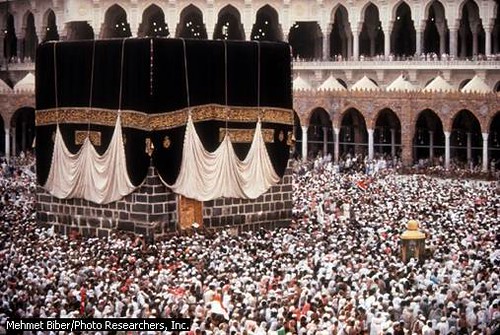
Pilgrimage to the Kaaba
Muslims consider the Kaaba—a small sanctuary near the center of the Great Mosque in Mecca— to be the most sacred spot on earth. Muslim legend teaches that the ancient religious patriarchs Abraham and Ishmael built the shrine using foundations first laid by Adam. Muslims all over the world orient themselves toward the Kaaba while praying, and every able Muslim is expected to make a pilgrimage to the Kaaba at least once in his or her lifetime. This picture shows pilgrimage ceremonies, which consist of several days of rituals and festivals during the Islamic month of pilgrimages, Dhu al-Hijja.
Mehmet Biber/Photo Researchers, Inc.
The fifth pillar requires that Muslims who have the physical and financial ability should perform the pilgrimage, or hajj, to Mecca at least once in a lifetime. The ritual of pilgrimage was practiced by Arabs before the rise of Islam and continues from the early days of Islam. The hajj is distinct from other pilgrimages. It must take place during the 12th lunar month of the year, known as Dhu al-Hijja, and it involves a set and detailed sequence of rituals that are practiced over the span of several days. All of the pilgrimage rituals take place in the city of Mecca and its surroundings, and the primary focus of these rituals is a cubical structure called the Kaaba. According to Islamic tradition, the Kaaba, also referred to as the House of God, was built at God's command by the prophet Ibrahim (Abraham of the Hebrew and Christian Bibles) and his son Ismail (see Ishmael).
The Qur’an provides detailed descriptions of various parts of the ritual, and it portrays many of these rituals as reenactments of the activities undertaken by Ibrahim and Ismail in the course of building the Kaaba. Set into one corner of the Kaaba is the sacred Black Stone, which according to one Islamic tradition was given to Ibrahim by the angel Gabriel. According to another Islamic tradition this stone was first set in place by Adam.
Once pilgrims arrive in Mecca, ritual purification is performed. Many men shave their heads, and most men and women put on seamless white sheets. This simple and common dress symbolizes the equality of all Muslims before God, a status further reinforced by the prohibition of jewelry, perfumes, sexual intercourse, and hunting. After this ritual purification, Muslims circle the Kaaba seven times, run between al-Safa and al-Marwa, two hills overlooking the Kaaba, seven times, and perform several prayers and invocations. This ritual is a reenactment of the search by Hagar for water to give her son Ismail.
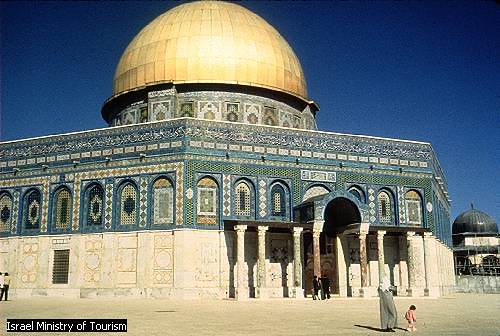
Dome of the Rock
The oldest extant Islamic structure, the Dome of the Rock stands on the sacred rock in Jerusalem where the Prophet Muhammad is believed to have ascended to heaven. Caliph Abd al-Malik built the mosque during the late 7th century. The mosque’s basic octagonal design encloses a central space topped by a dome. A rich mosaic decoration covers the outer walls.
Israel Ministry of Tourism
The final ritual is the slaughter of an animal (sheep, goat, cow, or camel). This is a symbolic reenactment of God's command to Ibrahim to sacrifice his son Ismail, which Ibrahim and Ismail duly accepted and were about to execute when God allowed Ibrahim to slaughter a ram in place of his son. Most of the meat of the slaughtered animals is to be distributed to poor Muslims. The ritual sacrifice ends the hajj and starts the festival of the sacrifice, ‘id al-adha. The festivals of breaking fast (‘id al-fitr) at the end of Ramadan and ‘id al-adha are the two major Islamic festivals celebrated by Muslims all over the world.
During the pilgrimage most Muslims visit Medina, where the tomb of the Prophet is located, before returning to their homes. If the pilgrimage rituals are performed at any time of the year other than the designated time for hajj, the ritual is called umra. Although umra is considered a virtuous act, it does not absolve the person from the obligation of hajj. Most pilgrims perform one or more umras before or after the hajj proper.
Many Muslims pilgrims also travel to Jerusalem, which is the third sacred city for Islam. Muslims believe Muhammad was carried to Jerusalem in a vision. The Dome of the Rock houses the stone from which Muhammad is believed to have ascended to heaven and Allah in a night journey. Some Muslims perform pilgrimages to the Dome of the Rock and to other shrines where revered religious figures are buried. Some of these shrines are important primarily to the local populations, whereas others draw Muslims from distant regions. There are no standard prescribed rituals for these pilgrimages nor are they treated as obligatory acts of worship.
| IV | THE MOSQUE |
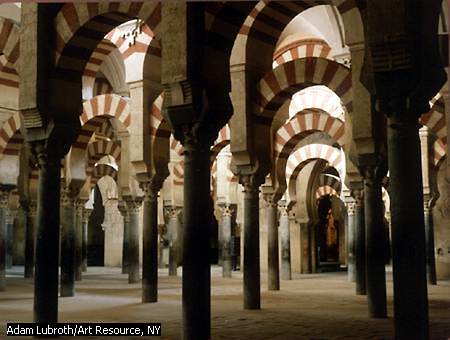
Mosque of Córdoba in Spain
This mosque in Córdoba, Spain, was begun in ad 786, while the city was the capital of Moorish Spain. Although the mosque became a Christian cathedral after the Roman Catholics of Spain captured Córdoba in 1236, the building retains its Islamic heritage. The mosque features columns that support horseshoe-shaped arches decorated with stripes of alternating colors. Layered in two tiers, these distinctly Moorish arches convey a light and airy feeling to the interior of the building.
Adam Lubroth/Art Resource, NY
Of all Muslim institutions, the mosque is the most important place for the public expression of Islamic religiosity and communal identity. A mosque is a physical manifestation of the public presence of Muslims and serves as a point of convergence for Islamic social and intellectual activity. The Arabic word for mosque is masjid, which means a 'place of prostration' before God. Mosques are mentioned in the Qur’an, and the earliest model for a mosque was the residence that the prophet Muhammad built when he moved to Medina. This first mosque was an enclosure marked as a special place of worship. A small part of the mosque was sectioned off to house the Prophet and his family, and the remaining space was left open as a place for Muslims to pray.
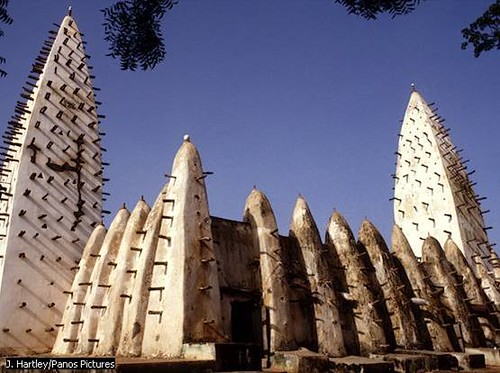
Mosque in Burkina Faso
The Grand Mosque of Bobo-Dioulasso in Burkina Faso is built of mud brick, the local building material. About half the people in Burkina Faso are Muslims.
J. Hartley/Panos Pictures

Mosque in Nouakchott
A mosque in Nouakchott, the capital of Mauritania. Islam is the state religion of Mauritania and is professed by nearly all Mauritanians.
Christian Sappa/RAPHO
The most important characteristic of a mosque is that it should be oriented toward Mecca. One or more niches (mihrab) on one of the walls of the mosque often serve as indicators of this direction, called qibla. When the imam leads the prayers he usually faces one of these niches. Next to the mihrab, a pulpit (minbar) is often provided for the delivery of sermons (khutba). Many mosques also have separate areas for performing ritual ablution, and separate sections for women. In many mosques, several rows of columns are used to mark the way for worshipers to line up behind the imam during prayer.
Mosques usually have one or more minarets, or towers, from which the muezzin calls Muslims to prayer five times a day. In addition to their functional use, these minarets have become distinguishing elements of mosque architecture. In large mosques in particular, minarets have the effect of tempering the enormity and magnificence of the domed structure by conveying to the viewer the elevation of divinity above the pretensions of human grandeur.
Most mosques also have a dome, and the line connecting the center of the dome to the niche is supposed to point toward Mecca. Throughout the world there are many mosques that are not actually directed toward Mecca, but such misalignment is due to inaccurate methods for determining the direction of Mecca and does not imply a disregard for this requirement. The mosque is not a self-contained unit, nor is it a symbolic microcosm of the universe, as are some places of worship in other religions. Rather, the mosque is always built as a connection with Mecca, the ultimate home of Muslim worship that metaphorically forms the center of all mosques. See Islamic Art and Architecture.
| V | THE GOD OF ISLAM |
Islamic doctrine emphasizes the oneness, uniqueness, transcendence, and utter otherness of God. As such, God is different from anything that the human senses can perceive or that the human mind can imagine. The God of Islam encompasses all creation, but no mind can fully encompass or grasp him. God, however, is manifest through his creation, and through reflection humankind can easily discern the wisdom and power behind the creation of the world. Because of God’s oneness and his transcendence of human experience and knowledge, Islamic law forbids representations of God, the prophets, and among some Muslims, human beings in general. As a result of this belief, Islamic art came to excel in a variety of decorative patterns including leaf shapes later stylized as arabesques, and Arabic script. In modern times the restrictions on creating images of people have been considerably relaxed, but any attitude of worship toward images and icons is strictly forbidden in Islam.
| A | Islamic Monotheism |
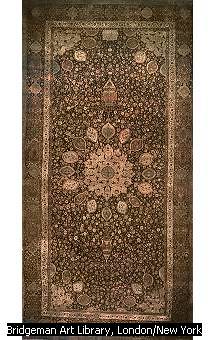
Ardabīl Carpet
This carpet was woven for the tomb-mosque of Shah Tahmasp at Ardabīl, Iran, in 1539 and 1540. Carpets like this often had more than 100 knots per sq cm (250 per sq in), so a team of weavers was needed to finish a carpet in a reasonable amount of time. The central design is a medallion shape, a traditional motif for mosque carpets.
Bridgeman Art Library, London/New York
Before Islam, many Arabs believed in a supreme, all-powerful God responsible for creation; however, they also believed in lesser gods. With the coming of Islam, the Arab concept of God was purged of elements of polytheism and turned into a qualitatively different concept of uncompromising belief in one God, or monotheism. The status of the Arabs before Islam is considered to be one of ignorance of God, or jahiliyya, and Islamic sources insist that Islam brought about a complete break from Arab concepts of God and a radical transformation in Arab belief about God.
Islamic doctrine maintains that Islam’s monotheism continues that of Judaism and Christianity. However, the Qur’an and Islamic traditions stress the distinctions between Islam and later forms of the two other monotheistic religions. According to Islamic belief, both Moses and Jesus, like others before them, were prophets commissioned by God to preach the essential and eternal message of Islam. The legal codes introduced by these two prophets, the Ten Commandments and the Christian Gospels, took different forms than the Qur’an, but according to Islamic understanding, at the level of doctrine they are the same teaching. The recipients of scriptures are called the people of the book or the 'scriptured' people. Like the Jews and the Christians before them, the Muslims became scriptured when God revealed his word to them through a prophet: God revealed the Qur’an to the prophet Muhammad, commanding him to preach it to his people and later to all humanity.
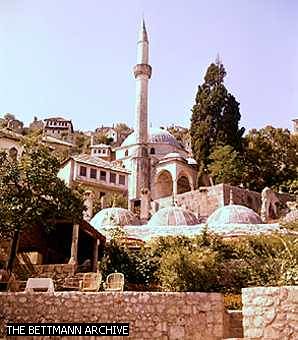
Mosque in Bosnia and Herzegovina
The Ottomans conquered most of Bosnia in 1463, and by 1483 controlled most of Herzegovina as well. The two territories, then separated, remained provinces of the Ottoman Empire for the next 400 years. Here, a mosque built by the Ottomans stands near Mostar. Mostar was severely damaged as a result of the civil war that followed Bosnia and Herzegovina’s declaration of independence from Yugoslavia in 1992.
THE BETTMANN ARCHIVE
According to Muslim belief, God sent Muhammad with the last and perfect legal code that balances the spiritual teachings with the law, and thus supplants the Jewish and Christian codes. According to the teachings of Islam, the Islamic code, called Sharia, is the final code, one that will continue to address the needs of humanity in its most developed stages, for all time. The Qur’an mentions 28 pre-Islamic prophets and messengers, and Islamic traditions maintain that God has sent tens of thousands of prophets to various peoples since the beginning of creation. Some of the Qur’anic prophets are familiar from the Hebrew Bible, but others are not mentioned in the Bible and seem to be prophetic figures from pre-Islamic Arabia.
For the Muslim then, Islamic history unfolds a divine scheme from the beginning of creation to the end of time. Creation itself is the realization of God's will in history. Humans are created to worship God, and human history is punctuated with prophets who guarantee that the world is never devoid of knowledge and proper worship of God. The sending of prophets is itself understood within Islam as an act of mercy. God, the creator and sustainer, never abandons his creations, always providing human beings with the guidance they need for their salvation in this world and a world to come after this one. God is just, and his justice requires informing people, through prophets, of how to act and what to believe before he holds them accountable for their actions and beliefs. However, once people receive the teachings of prophets and messengers, God's justice also means that he will punish those who do wrong or do not believe and will reward those who do right and do believe. Despite the primacy of justice as an essential attribute of God, Muslims believe that God’s most fundamental attribute is mercy.
| B | Humanity’s Relationship to God |
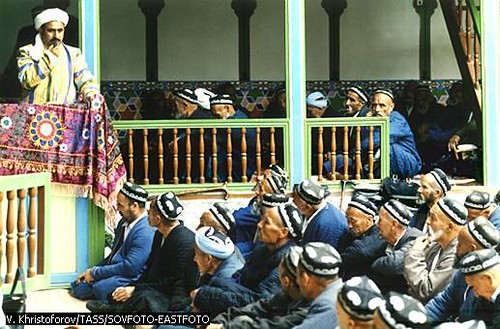
Mosque in Tajikistan
A majority of Tajikistan’s inhabitants are ethnic Tajiks, who are predominantly Muslim. Under Soviet rule (1921-1991), religion was severely restricted; mosques were closed and religious practice was prohibited outside of state-sanctioned places of worship. Restrictions were eased somewhat in the mid-1980s, but it was not until Tajikistan became independent in 1991 that Muslims were again able to freely practice their religion.
V. Khristoforov/TASS/SOVFOTO-EASTFOTO
According to Islamic belief, in addition to sending prophets, God manifests his mercy in the dedication of all creation to the service of humankind. Islamic traditions maintain that God brought the world into being for the benefit of his creatures. His mercy toward humanity is further manifested in the privileged status God gave to humans. According to the Qur’an and later traditions, God appointed humankind as his vice regents (caliphs) on earth, thus entrusting them with the grave responsibility of fulfilling his scheme for creation.
The Islamic concept of a privileged position for humanity departs from the early Jewish and Christian interpretations of the fall from Paradise that underlie the Christian doctrine of original sin. In the biblical account, Adam and Eve fall from Paradise as a result of disobeying God’s prohibition, and all of humanity is cast out of Paradise as punishment. Christian theologians developed the doctrine that humankind is born with this sin of their first parents still on their souls, based upon this reading of the story. Christians believe that Jesus Christ came to redeem humans from this original sin so that humankind can return to God at the end of time. In contrast, the Qur’an maintains that after their initial disobedience, Adam and Eve repented and were forgiven by God. Consequently Muslims believe that the descent by Adam and Eve to earth from Paradise was not a fall, but an honor bestowed on them by God. Adam and his progeny were appointed as God's messengers and vice regents, and were entrusted by God with the guardianship of the earth.
| C | Angels |
The nature of humankind’s relationship to God can also be seen clearly by comparing it with that of angels. According to Islamic tradition, angels were created from light. An angel is an immortal being that commits no sins and serves as a guardian, a recorder of deeds, and a link between God and humanity. The angel Gabriel, for example, communicated God's message to the prophet Muhammad. In contrast to humans, angels are incapable of unbelief and always obey God. Some followers of Islam view Satan as an angel who was unusual in his ability to defy God, while others view him as a jinn, or spirit created by God from smokeless fire, who roamed among the angels.
Despite these traits, Islamic doctrine holds that humans are superior to angels. According to Islamic traditions, God entrusted humans and not angels with the guardianship of the earth and commanded the angels to prostrate themselves to Adam. Satan, together with the other angels, questioned God's appointment of fallible humans to the honorable position of viceregency. Being an ardent monotheist, Satan disobeyed God and refused to prostrate himself before anyone but God. For this sin, Satan was doomed to lead human beings astray until the end of the world. According to the Qur’an, God informed the angels that he had endowed humans with a knowledge angels could not acquire.
| D | Islamic Theology |
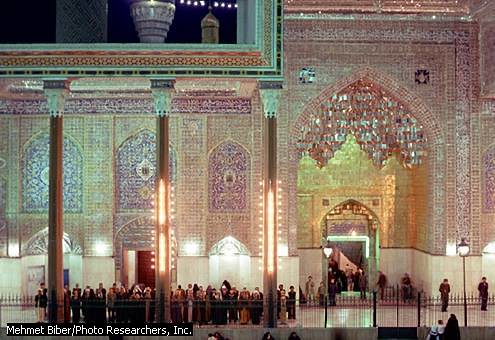
Kazimayn Mosque
The gold-domed Kazimayn Mosque, pictured at night, is near Baghdād in Iraq. This famous building, begun in the 11th century and completed in the 19th century, contains the tombs of revered Shia Muslim leaders.
Mehmet Biber/Photo Researchers, Inc.

Mosque in Vladikavkaz
This mosque serves members of the Muslim minority in Vladikavkaz, the capital of the Russian republic of Alania (North Ossetia).
SOVFOTO-EASTFOTO
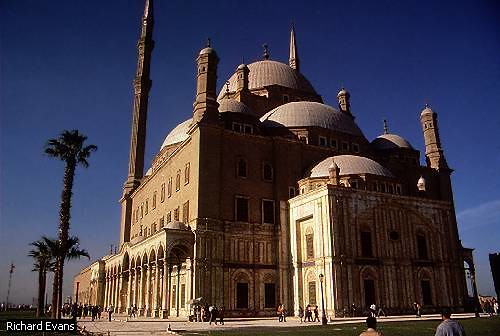
Mosque of Muhammad Ali, Cairo
The Mosque of Muhammad Ali stands within the walls of the Citadel in Cairo. Built between 1830 and 1857, it is the largest and grandest of the four mosques contained in the Citadel. Cairo has been an Islamic cultural center for more than 1000 years.
Richard Evans
Another controversial issue was the question of whether the Qur’an was eternal or created in time. Theologians who were devoted to the concept of God's oneness maintained that the Qur’an must have been created in time, or else there would be something as eternal as God. This view was rejected by others because the Qur’an, the ultimate authority in Islam, states in many places and in unambiguous terms that it is the eternal word of God.
Many other theological controversies occupied Muslim thinkers for the first few centuries of Islam, but by the 10th century the views of Islamic theologian al-Ashari and his followers, known as Asharites, prevailed and were adopted by most Muslims. The way this school resolved the question of free will was to argue that no human act could occur if God does not will it, and that God's knowledge encompasses all that was, is, or will be. This view also maintains that it is God's will to create the power in humans to make free choices. God is therefore just to hold humans accountable for their actions. The views of al-Ashari and his school gradually became dominant in Sunni, or orthodox, Islam, and they still prevail among most Muslims. The tendency of the Sunnis, however, has been to tolerate and accommodate minor differences of opinion and to emphasize the consensus of the community in matters of doctrine.
As is the case with any religious group, ordinary Muslims have not always been concerned with detailed theological controversies. For ordinary Muslims the central belief of Islam is in the oneness of God and in his prophets and messengers, culminating in Muhammad. Thus Muslims believe in the scriptures that God sent through these messengers, particularly the truth and content of the Qur’an. Whatever their specific religious practices, most Muslims believe in angels, the Day of Judgment, heaven, paradise, and hell.
| VI | THE PROPHET MUHAMMAD |
Belief in the message of Muhammad comes second only to belief in the one God. Muhammad was born around the year 570 and was orphaned at an early age. He was eventually raised by his uncle, who had religious prominence within the main Quraysh tribe of Mecca but was of modest financial means. At age 25, Muhammad married Khadija, a well-to-do, 40-year-old woman. At age 40, during a retreat in the hills outside Mecca, Muhammad had his first experience of Islam. The angel Gabriel appeared to a fearful Muhammad and informed him that he was God's chosen messenger. Gabriel also communicated to Muhammad the first revelation from God. Terrified and shaken, Muhammad went to his home. His wife became the first person to accept his message and convert to Islam. After receiving a series of additional revelations, Muhammad started preaching the new religion, initially to a small circle of relatives and friends, and then to the general public.
The Meccans first ignored Muhammad, then ridiculed him. As more people accepted Muhammad's call, the Meccans became more aggressive. After failing to sway Muhammad away from the new religion they started to persecute his less prominent followers. When this approach did not work, the opposing Meccans decided to persecute Muhammad himself. By this time, two main tribes from the city of Yathrib, about 300 km (200 mi) north of Mecca, had invited Muhammad to live there. The clan leaders invited Muhammad to Yathrib as an impartial religious authority to arbitrate disputes. In return, the leaders pledged to accept Muhammad as a prophet and thus support the new religion of Islam.
| A | Hegira |
In the year 622, Muhammad immigrated to Yathrib, and the name of the city was changed to Medina, meaning city of the Prophet. This date was designated by later Muslims as the beginning of the Muslim calendar, year one of hegira (Arabic hijra, “immigration”). Only two years after Muhammad's arrival in Medina, the core community of Muslims started to expand. At Medina, in addition to preaching the religious and moral message of Islam, Muhammad organized an Islamic society and served as head of state, diplomat, military leader, and chief legislator for the growing Muslim community. Hostilities soon broke out between the Muslims in Medina and the powerful Meccans. In 630, after a series of military confrontations and diplomatic maneuvers, the Muslims in Medina extended their authority over Mecca, the most important city of Arabia at the time. Before Muhammad died in 632, the whole Arabian Peninsula was united for the first time in its history, under the banner of Islam.
| B | Muhammad’s Humanity |
Early accounts of Muhammad contain some stories that describe supernatural events such as his night journey from Mecca to Jerusalem and his subsequent ascent to heaven on the back of a supernatural winged horse. Despite such stories, the primary focus of the biographies, as well as Islamic doctrine in general, is on the humanity of Muhammad.
Like all prophets before him, Muhammad was a mortal man, commissioned by God to deliver a message to his people and to humanity. Like other prophets, Muhammad was distinguished from ordinary people by certain powers and faculties. For example, Muslims believe that the distinction of being sinless was granted to Muhammad by God to support his career as a prophet. Thus Muhammad is portrayed in the Qur’an as a person who makes mistakes but who does not sin against God. However, God corrected Muhammad’s mistakes or errors in judgment, so that his life serves as an example for future Muslims to follow. This emphasis on Muhammad's humanity serves as a reminder that other humans can reasonably aspire to lead a good life as he did.
| VII | THE QUR’AN |
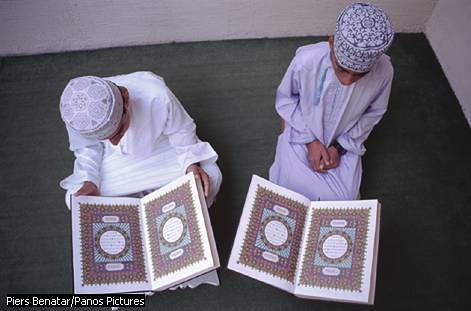
Muslim Boys Studying the Qur’an
The Qur’an is at the center of Muslim life. Muslims recite verses from it in their daily prayers and at important public and private events. Many Muslims also memorize this holy scripture so that they can keep it in their hearts. Before touching the holy book, Muslims follow rituals for purification, including washing and preparing the mind, body, and spirit. Care must be taken that the Qur’an does not come into contact with any unclean substance, and it is never to be laid upon the ground.
Piers Benatar/Panos Pictures
As with other prophets and messengers, God supported Muhammad by allowing him to work miracles and thus prove that he was a genuine prophet. The singular miracle of Muhammad and the ultimate proof of the truthfulness of Islam is the Qur’an. In accordance with the words of the scripture itself, Muslims believe that the Qur’an is the timeless word of God, “the like of which no human can produce.” This trait of the scripture, called inimitability (i'jaz), is based on belief in the divine authorship of the Qur’an. Unlike earlier religions, the miracle of Islam is a literary miracle, and Muhammad's other supernatural acts are subordinate to it.
This belief in the unique nature of the Qur’an has led Muslims to devote great intellectual energies to the study of its contents and form. In addition to interpreting the scripture and deriving doctrines and laws from it, many disciplines within Qur’anic studies seek to understand its linguistic and literary qualities as an expression of its divine origins.
| A | The Format of the Holy Book |
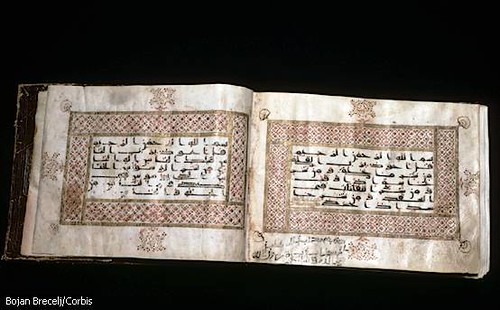
Illustrated Text of the Qur’an
This beautifully decorated page comes from a Qur’an of the late 8th century or early 9th century. Muslims believe that the Qur’an is an infallible transcription of God’s message to Muhammad. As the messenger of God and seal of the prophets, Muhammad was charged with the responsibility of relaying this message to all believers. Divided into 114 suras, or chapters, the Qur’an is meant to be recited or chanted as part of Islamic worship.
Bojan Brecelj/Corbis
The Qur’an is made up of 114 chapters, called suras, which appear, from the second chapter onward, roughly in order of length, beginning with the longest and ending with the shortest chapters. The first chapter, al-Fatiha (“the Opening”), is a short chapter that is recited during each of the five daily prayers and in many other ritual prayers. All but one chapter begin with the formula 'in the name of God, the Merciful Lord of Mercy' (bism Allah al-Rahman al-Rahim). Each chapter is divided into verses called ayat (singular aya, meaning “sign” or “proof”). With few exceptions the verses are randomly organized without a coherent narrative thread.
A typical chapter of the Qur’an may address any combination of the following themes: God and creation, prophets and messengers from Adam to Jesus, Muhammad as a preacher and as a ruler, Islam as a faith and as a code of life, disbelief, human responsibility and judgment, and society and law. Later Muslim scholars have argued that the text’s timelessness and universality explain the lack of narrative coherence and the randomness of the topics. In other words, the multiple meanings of the Qur’an transcend linear narrative as they transcend any particular historical moment.
| B | The Qur’an and the Bible |
Islam recognizes the divine origins of the earlier Hebrew and Christian Scriptures and represents itself as both a restoration and a continuation of their traditions. Because of this, the Qur’an draws on biblical stories and repeats many biblical themes. In particular, the stories of several biblical prophets appear in the Qur’an, some in a condensed form; other stories, such as those of Abraham, Moses, and Jesus, are given in elaborate detail and even with subtle revisions of the biblical accounts.
One of the important differences between the Qur’anic and biblical stories of Abraham's sacrifice of his son, for example, is that the Qur’an suggests this son is Ishmael, from whom Arabs are descended, and not Isaac, from whom the tribes of Israel are descended. A more substantial difference relates to the Islamic story of Jesus, who according to the Qur’an is a mortal, human prophet. The Islamic faith categorically rejects the idea that God was ever born, as opposed to Christian belief that Jesus was born the son of God. Islam also rejects the idea that God shared his divinity with any other being.
Another important idea elaborated in the Qur’an and later Islamic doctrine, in conscious distinction from the biblical accounts, is that although prophets are capable of human errors, God protects them from committing sins and also protects them from excruciating suffering or humiliating experiences. God would not abandon his prophets in times of distress. Therefore, the Qur’an maintains that God interfered to save Jesus from torture and death by lifting him to heaven and replacing him on the cross with someone who looked like him.
| C | The Preservation of the Qur’an |
From its inception during the lifetime of Muhammad, Islamic doctrine gave priority to the preservation of the scripture. As a result, one of the earliest expressions of religiosity focused on studying, reciting, and writing down the scripture. When Muhammad died, the preservation of the scripture was also a conscious concern among his companions and successors. Early historical sources refer to immediate efforts undertaken by successors of Muhammad to collect the chapters of the Qur’an, which were written down by his various companions.
Within about two decades after the death of the Prophet, various existing copies of parts of the Qur’an were collected and collated by a committee of close companions of Muhammad who were known for their knowledge of the Qur’an. This committee was commissioned by the third successor of Muhammad, Uthman ibn Affan, and the committee’s systematic effort is the basis of the codified official text currently used by Muslims. The thematic randomness of the verses and chapters of the Qur’an in its current format clearly illustrates that the early companions who produced this official version of the Qur’an were primarily concerned with establishing the text and made no attempt to edit its contents in order to produce a coherent narrative. Because of this, scholars agree that the Uthmanic text genuinely reflects, both in its content and form, the message that Muhammad preached.
| D | Interpretations of the Qur’an |
Despite the consensus among Muslims on the authenticity of the current format of the Qur’an, they agree that many words in the Qur’an can be interpreted in equally valid ways. The Arabic language, like other Semitic languages, has consonants and vowels, and the meanings of words are derived from both. For several centuries, the written texts of the Qur’an showed only the consonants, without indicating the vowel marks. As a result, there are different ways in which many words can be vocalized, with different meanings; this allows for various legitimate interpretations of the Qur’an.
One of the disciplines for the study of the Qur’an is exclusively dedicated to the study and documentation of acceptable and unacceptable variant readings. According to Muslim scholars, there are some 40 possible readings of the Qur’an, of which 7 to 14 are legitimate. The legitimacy of different possible interpretations of the scripture is supported by a statement in the Qur’an that describes verses as either unambiguously clear, or as ambiguous because they carry a meaning known only to God. Therefore, with the exception of a small number of unquestionably clear injunctions, the meaning of the Qur’anic verses is not always final.
The Qur’an is the primary source of authority, law and theology, and identity in Islam. However, in many cases it is either completely silent on important Islamic beliefs and practices or it gives only general guidelines without elaboration. This is true of some of the most basic religious obligations such as prayer, which the Qur’an prescribes without details. Details elaborating on the teachings and laws of the Qur’an are derived from the sunna, the example set by Muhammad’s life, and in particular from hadith, the body of sayings and practices attributed to him.
| VIII | HADITH |
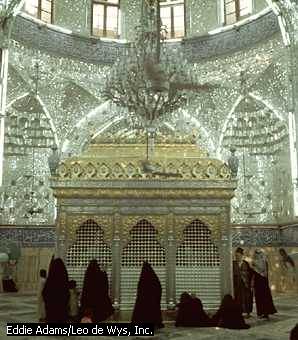
Shrine of Abbas
The shrine of Abbas in Karbalā, Iraq, is a pilgrimage site for Shia Muslims. Abbas was the son of Ali, the son-in-law of the prophet Muhammad. Abbas was martyred and buried in Karbalā. His tomb is in a domed chamber that shimmers with silver mirrors.
Eddie Adams/Leo de Wys, Inc.
As the second source of authority in Islam, hadith complements the Qur’an and provides the most extensive source for Islamic law. The ultimate understanding of the Qur’an depends upon the context of Muhammad’s life and the ways in which he demonstrated and applied its message. There is evidence that Muhammad's sayings and practices were invoked by his companions to answer questions about Islam. Unlike the Qur’an, however, in the early periods hadith was circulated orally, and no attempts were made to establish or codify it into law until the beginnings of the second century of Islam.
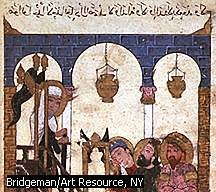
Preaching in the Mosque
Book illustration was an essential Islamic art, which flourished from the 7th to the 18th century. This manuscript page shows Abu Zayd preaching in the mosque of Samarqand. Islamic art focused on book arts rather than easel painting because it was believed that art should serve a function, that of education.
Bridgeman/Art Resource, NY

Jumeirah Mosque
The Jumeirah Mosque is located in the city of Dubai, in the United Arab Emirates. Dubai is the chief port and commercial center of the Emirates.
SIME/Schmid Reinhard/4Corners Images
Historically, the compilation of hadith went hand in hand with the elaboration of Islamic law and the parallel development of Islamic legal theory. Initially, neither the law nor its procedures were systematically elaborated, although there can be little doubt that both the Qur’an and hadith were regularly invoked and used to derive laws that governed the lives of Muslims. By the beginning of the 9th century, the use of these two sources was systematized and a complex legal theory was introduced. In its developed form, this theory maintains that there are four sources from which Islamic law is derived. These are, in order of priority, the Qur’an, the hadith, the consensus of the community (ijma), and legal analogy (qiyas). Functional only when there is no explicit ruling in the Qur’an or hadith, consensus confers legitimacy retrospectively on historical practices of the Muslim community. In legal analogy, the causes for existing Islamic rulings are applied by analogy to similar cases for which there are no explicit statements in either the Qur’an or hadith. Using these methods, a vast and diverse body of Islamic law was laid out covering various aspects of personal and public life.
In addition to the laws pertaining to the five pillars, Islamic law covers areas such as dietary laws, purity laws, marriage and inheritance laws, commercial transaction laws, laws pertaining to relationships with non-Muslims, and criminal law. Jews and Christians living under Muslim rule are subject to the public laws of Islam, but they have traditionally been permitted to run their internal affairs on the basis of their own religious laws.
| IX | THE SPREAD OF ISLAM |
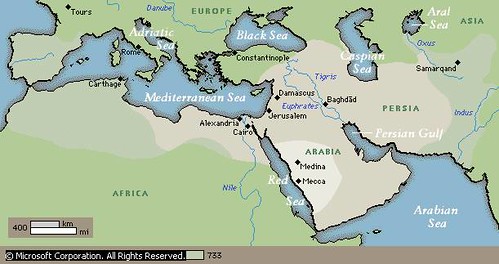
Spread of Islam
In the 7th and 8th centuries the religion of Islam spread through conversion and military conquest throughout the Middle East and North Africa. By 733, just 100 years after the death of Muhammad, the founder of Islam, an ordered Islamic state stretched from India in the east to Spain in the west.
© Microsoft Corporation. All Rights Reserved.
Since its inception Islam has been perceived by Muslims to be a universal code. During Muhammad's lifetime, two attempts were made to expand northward into the Byzantine domain and its capital in Constantinople, and within ten years after Muhammad’s death, Muslims had defeated the Sassanids of Persia and the Byzantines, and had conquered most of Persia, Iraq, Syria, and Egypt. The conquests continued, and the Sassanian Empire was soon after destroyed and the influence of Byzantium was largely diminished (see Byzantine Empire). For the next several centuries intellectuals and cultural figures flourished in the vast, multinational Islamic world, and Islam became the most influential civilization in the world.
| A | The Rightly Guided Caliphs |
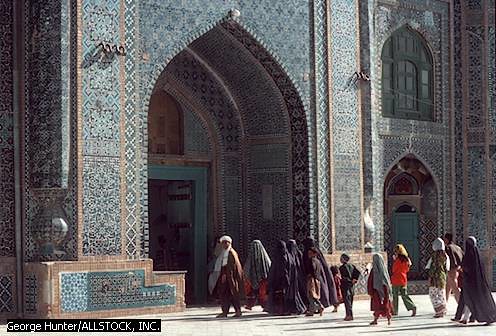
Mosque at Mazār-e Sharīf
Muslims from all over the country make pilgrimages to the 15th-century mosque at Mazār-e Sharīf in northern Afghanistan. The religious significance of the site derives from the belief that the tomb of Ali, fourth caliph of Islam and son-in-law of Muhammad, the founder of Islam, lies within the mosque. More than 99 percent of the population of Afghanistan practices Islam.
George Hunter/ALLSTOCK, INC.
The first four successors of Muhammad, known as rightly guided caliphs, ruled for some 30 years (see Caliphate). Their rule, together with that of Muhammad, is considered by most Muslims to constitute the ideal Islamic age. The second caliph, Umar, ruled from ad 634 to 644; he is credited with being the first caliph to found new Islamic cities, Al Başra (ad 635) and Kūfah (ad 638). The administration of the eastern and western Islamic provinces was coordinated from these two sites. After the third caliph, Uthman, was murdered by a group of Muslim mutineers, the fourth caliph, Ali, succeeded to power and moved his capital to Kūfah in Iraq. From this capital he fought the different opposition factions. Among the leaders of these factions, Mu’awiyah, governor of the rich province of Syria and a relative of Uthman, outlasted Ali. After Ali’s death in 661, Mu’awiyah founded the Umayyad dynasty, which ruled a united Islamic empire for almost a century. Under the Umayyads the Islamic capital was shifted to Damascus. See Spread of Islam.
| B | Shia Islam |
The followers of Ali were known as the Shia (partisans) of Ali. Although they began as a political group, the Shia, or Shia Muslims, became a sect with specific theological and doctrinal positions. A key event in the history of the Shia and for all Muslims was the tragic death at Karbala of Husayn, the son of Ali, and Muhammad's daughter Fatima. Husayn had refused to recognize the legitimacy of the rule of the Umayyad Yazid, the son of Mu’awiyah, and was on his way to rally support for his cause in Kūfah. His plans were exposed before he arrived at Kūfah, however, and a large Umayyad army met him and 70 members of his family at the outskirts of the city. The Umayyads offered Husayn the choice between a humiliating submission to their rule or a battle and definite death. Husayn chose to fight, and he and all the members of his family with him were massacred. The incident was of little significance from a military point of view, but it was a defining moment in the history of Shia Islam. Although not all Muslims are Shia Muslims, all Muslims view Husayn as a martyr for living up to his principles even to death.
The Twelver Shia, or Ithna-‘Ashariyya, is the largest of the Shia Muslim sects. They believe that legitimate Islamic leadership is vested in a line of descent starting with Muhammad's cousin and son-in-law, Ali, through Ali's two sons, Hasan and Husayn, and then through Husayn's descendants. These were the first 12 imams, or leaders of the Shia Muslim community. The Shia Muslims believe that Muhammad designated all 12 successors by name and that they inherited a special knowledge of the true meaning of the scripture that was passed from father to son, beginning with the Prophet himself. This family, along with its loyal followers and representatives, has political authority over the Shia Muslims.
| C | Sunni Islam |
Sunni Islam was defined during the early Abbasid period (beginning in ad 750), and it included the followers of four legal schools (the Malikis, Hanafis, Shafi’is, and Hanbalis). In contrast to the Shias, the Sunnis believed that leadership was in the hands of the Muslim community at large. The consensus of historical communities, not the decisions of political authorities, led to the establishment of the four legal schools. In theory a Muslim could choose whichever school of Islamic thought he or she wished to follow and could change this choice at will. The respect and popularity that the religious scholars enjoyed made them the effective brokers of social power and pitched them against the political authorities.
After the first four caliphs, the religious and political authorities in Islam were never again united under one institution. Their usual coexistence was underscored by a mutual recognition of their separate spheres of influence and their respective duties and responsibilities. Often, however, the two powers collided, and invariably any social opposition to the elite political order had religious undertones.
| D | Sufism |

Whirling Dervishes
In the Middle Ages the great Sufi orders, which had several million adherents, were established; about 100 orders still exist, many of them in Turkey and Iran. One of the most influential founders of orders was the Persian poet Jalal al-Din Muhammad Rumi, who, in addition to composing poetry and other works, instituted devotional dances, particularly those of the whirling dervishes.
BBC Worldwide Americas, Inc.
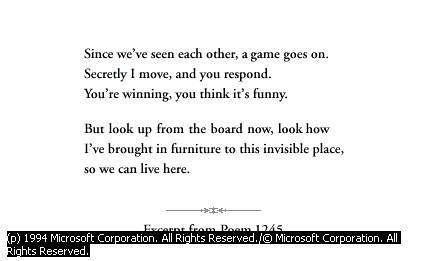
Rumi
Sufism, or Islamic mysticism, influenced the lyrical poetry of 13th-century Persian writer Jalal al-Din Rumi. He explored spiritual concepts such as the meaning of life and the ultimate need for the human soul to unite with God. Rumi often used the second person “you” in his poetry, but he frequently disguised the identity of the “you.” For example, the subject of Rumi’s poem 1245 (recited by an actor) may be a human lover, God, another part of himself, or a combination of all three.
(p) 1994 Microsoft Corporation. All Rights Reserved./© Microsoft Corporation. All Rights Reserved.
The Sufi emphasis on intuitive knowledge and the love of God increased the appeal of Islam to the masses and largely made possible its extension beyond the Middle East into Africa and East Asia. Sufi brotherhoods multiplied rapidly from the Atlantic coast to Indonesia; some spanned the entire Islamic world, others were regional or local. The tremendous success of these fraternities was due primarily to the abilities and humanitarianism of their founders and leaders, who not only ministered to the spiritual needs of their followers but also helped the poor of all faiths and frequently served as intermediaries between the people and the government.
| E | The Abbasid Dynasty |
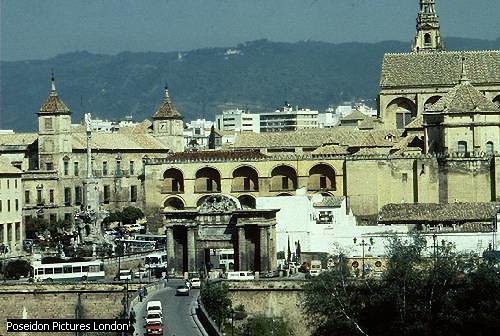
Córdoba, Spain
The Moorish history of the city of Córdoba in Spain dates from the 8th century, when the city became a Muslim caliphate. The Moorish influence can still be seen in much of the architecture, including the city’s famous cathedral, originally an impressive mosque.
Poseidon Pictures London
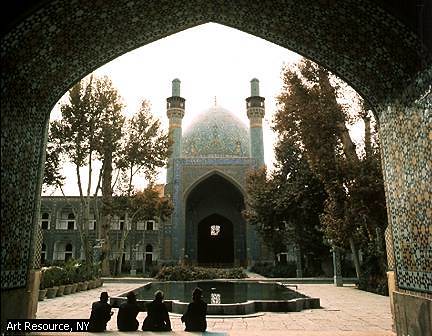
Courtyard, Madrasa, Eşfahān
A madrasa is a place for learning and prayer. This view into the courtyard of the Madrasa Chahār Bāgh in Eşfahān, Iran, shows the domed mosque, central pool, and rooms around the courtyard for study and accommodation. The madrasa was built from 1706 to 1714.
Art Resource, NY

Baghdād, Iraq
Baghdād became the capital city of the newly created kingdom of Iraq in 1921, but the city’s history dates back many centuries more. Built in ad 762 on a fertile plain next to the Tigris River in central Iraq, Baghdād is the country's largest city and its center of transportation and manufacturing. In 1991, however, heavy bombing during the Persian Gulf War destroyed much of the city's industry and transportation network.
Barry Iverson/Woodfin Camp and Associates, Inc.
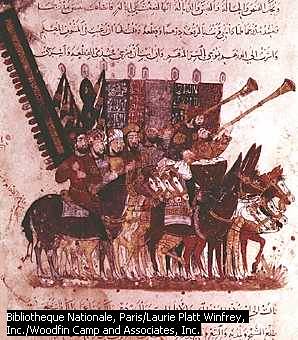
Persian Manuscript
During the rule of the Abbasid caliphs, from 750 to 1258, Islamic culture flourished. This 13th-century Persian manuscript was created during this period. Islamic art used input from neighboring cultures including the Persians in the development of a cohesive Islamic style of art.
Bibliotheque Nationale, Paris/Laurie Platt Winfrey, Inc./Woodfin Camp and Associates, Inc.
In 1258, however, a grandson of Mongol ruler Genghis Khan named Hulagu, encouraged by the kings of Europe, led his armies across the Zagros Mountains of Iran and destroyed Baghdād. According to some estimates, about 1 million Muslims were murdered in this massacre. In 1259 and 1260 Hulagu's forces marched into Syria, but they were finally defeated by the Mamluks of Egypt, who had taken over the Nile Valley. For the next two centuries, centers of Islamic power shifted to Egypt and Syria and to a number of local dynasties. Iraq became an impoverished, depopulated province where the people took up a transitory nomadic lifestyle. Iraq did not finally experience a major cultural and political revival until the 20th century.
| X | THE PRESENCE OF ISLAM IN THE 20TH CENTURY |
Many of the accepted Islamic religious and cultural traditions were established between the 7th and 10th centuries, during the classical period of Islamic history. However, Islamic culture continued to develop as Islam spread into new regions and mixed with diverse cultures. The 19th-century occupation of most Muslim lands by European colonial powers was a main turning point in Muslim history. The traditional Islamic systems of governance, social organization, and education were undermined by the colonial regimes. Nation-states with independent governments divided the Muslim community along new ethnic and political lines.
Today about 1 billion Muslims are spread over 40 predominantly Muslim countries and 5 continents, and their numbers are growing at a rate unmatched by that of any other religion in the world. Despite the political and ethnic diversity of Muslim countries, a core set of beliefs continues to provide the basis for a shared identity and affinity among Muslims. Yet the radically different political, economic, and cultural conditions under which contemporary Muslims live make it difficult to identify what constitutes standard Islamic practice in the modern world. Many contemporary Muslims draw on the historical legacy of Islam as they confront the challenges of modern life. Islam is a significant, growing, and dynamic presence in the world. Its modern expressions are as diverse as the world in which Muslims live.
Contributed By:
Ahmad S. Dallal
Microsoft ® Encarta ® 2007. © 1993-2006 Microsoft Corporation. All rights reserved.




0 komentar:
Posting Komentar